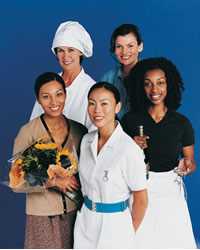Women's Safety and Health Issues at Work

Health Concerns: Ergonomics and Muscle/Bone Disorders
Muscle/bone or "musculoskeletal" disorders are illnesses or injuries of the muscles, nerves, tendons, joints, cartilage, arms, legs, neck, or lower back. Musculoskeletal disorders are caused or made worse by sudden force, repetitious movement, constant vibration, or awkward posture. Ergonomics is a field of science that works to find solutions to ensure workers stay safe, comfortable, and productive. These solutions usually involve changing tools, equipment, materials, work methods, or the work environment to prevent musculoskeletal disorders.
More research is needed to figure out why women have a higher chance of getting musculoskeletal disorders than men. The higher rate of these disorders among women could be related to job differences or physical differences between men and women.
NIOSH Publications
Preventing Slips, Trips,and Falls in Wholesale and Retail Trade Establishments
DHHS (NIOSH) Publication No. 2013-100 (October 2012)
Safety and Health among Hotel Cleaners
DHHS (NIOSH) Publication No. 2012-151 (July 2012)
Injuries, Illnesses & Fatalities in Wholesale and Retail Trade in 2005: A Chartbook
DHHS (NIOSH) Publication No. 2012-106 (December 2011)
Slip, Trip, and Fall Protection for Healthcare Workers
DHHS (NIOSH) Publication No. 2011-123 (December 2010)
Musculoskeletal Disorders in Manufacturing
DHHS (NIOSH) Publication No. 2010-129 (March 2010)
Safe Patient Handling Training for Schools of Nursing: Curricular Materials
DHHS (NIOSH) Publication No. 2009-127 (March 2010)
Ergonomic Guidelines for Manual Material Handling
DHHS (NIOSH) Publication No. 2007-131 (April 2007)
Control of Ergonomic Hazards in Commercial Drycleaning
DHHS (NIOSH) Publication No. 97-150 (December 1997)
Musculoskeletal Disorders and Workplace Factors: A Critical Review of Epidemiologic Evidence for Work-Related Musculoskeletal Disorders of the Neck, Upper Extremity, and Low Back
DHHS (NIOSH) Publication No. 97-141 (July 1997)
Related Resources
Clinical guidelines for occupational lifting in pregnancy: evidence summary and provisional recommendations
Empirically-based lifting criteria established by the National Institute for Occupational Safety and Health (NIOSH) to reduce risk of overexertion injuries in the general U.S. working population were evaluated for application to pregnant workers. This report proposes criteria to guide decisions by medical providers about permissible weights for lifting tasks performed at work over the course of an uncomplicated pregnancy. Our evaluation included an extensive review of the literature linking occupational lifting to maternal and fetal health. Although it has been 29 years since the American Medical Association’s (AMA) Council on Scientific Affairs published its report on the Effects of Pregnancy on Work Performance, these guidelines continue to influence clinical decisions and workplace policies. Provisional clinical guidelines derived from the NIOSH lifting criteria are presented that account for recent evidence for maternal and fetal health, and aim to improve the standard of care for pregnant workers.
Physical activity, physical exertion, and miscarriage risk in women textile workers in Shanghai, China
Compared with women working in sedentary jobs, a reduced risk of miscarriage was found for women working in jobs with either light or medium physical activity during the first pregnancy and over all pregnancies. Frequent crouching was associated with elevated risk. Among conclusions was that light/medium occupational physical activity may have reduced miscarriage risk, while specific occupational characteristics such as crouching may have increased risk in this group.
Suggestions for preventing musculoskeletal disorders in home healthcare workers part 1: lift and transfer assistance for partially weight-bearing home care patients
The article describes ways to help patients with higher upper body strength or weight-bearing ability, as well as equipment to help prevent muscle and bone injury of home healthcare workers.
- Hoskins, A. Occupational injuries, illnesses, and fatalities among women. Monthly Labor Review Online. 2005.
- Page last reviewed: July 22, 2013
- Page last updated: July 10, 2013
- Content source:
- National Institute for Occupational Safety and Health
Office of the Director
- National Institute for Occupational Safety and Health


 ShareCompartir
ShareCompartir